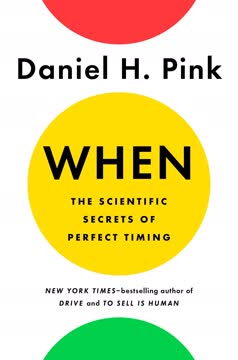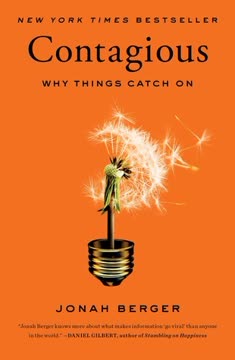Key Takeaways
1. Change Minds by Removing Roadblocks, Not Pushing Harder
"To change minds and overcome such inertia, the tendency is to push. But along the way, we tend to forget about the person whose mind we're trying to change. And what's stopping them."
The Catalyst Approach. Traditional methods of changing minds often involve pushing harder with more information, reasons, or force. However, this approach frequently backfires, causing people to resist change even more. Instead, effective change agents act as catalysts by identifying and removing the barriers that prevent people from changing.
Five Key Roadblocks:
- Reactance: People's instinct to resist when they feel their choices are restricted
- Endowment: The tendency to overvalue what we already have
- Distance: The gap between current beliefs and the proposed change
- Uncertainty: Doubt about the benefits or consequences of change
- Lack of Corroborating Evidence: Insufficient proof or support for the change
By focusing on removing these roadblocks rather than pushing harder, catalysts can more effectively facilitate change in various contexts, from personal relationships to organizational transformations.
2. Reduce Reactance: Allow for Agency and Encourage Self-Persuasion
"To reduce reactance, catalysts allow for agency—not by telling people what to do or by being completely hands-off, but by finding the middle ground. By guiding their path."
Provide Choices. Instead of dictating actions, offer a menu of options that align with the desired outcome. This approach gives people a sense of control and reduces their resistance to change.
Ask, Don't Tell. Use questions to guide people towards their own conclusions rather than presenting direct arguments. This technique encourages self-reflection and increases buy-in.
Effective Techniques:
- Highlight gaps between attitudes and behaviors
- Start with understanding before attempting to influence
- Use open-ended questions to stimulate thinking
- Provide a menu of choices rather than a single directive
By allowing people to feel that they are making their own decisions, catalysts can significantly reduce reactance and increase the likelihood of successful change.
3. Ease Endowment: Surface the Costs of Inaction and Inertia
"To overcome endowment, then, we need to help people realize the cost of doing nothing—that, rather than being safe or costless, sticking with the status quo actually has a downside."
Highlight Hidden Costs. People often overvalue what they already have (the endowment effect) and underestimate the costs of maintaining the status quo. Catalysts can overcome this by making the costs of inaction more visible and tangible.
Create Urgency. By demonstrating that the current situation is not as stable or beneficial as it seems, catalysts can motivate people to consider change more seriously.
Strategies to Ease Endowment:
- Quantify the long-term costs of maintaining the status quo
- Demonstrate how the current situation may be deteriorating
- Show how competitors or peers are benefiting from change
- Frame the change as regaining something lost, rather than acquiring something new
By helping people realize that inaction is not costless, catalysts can overcome the powerful pull of the status quo and motivate change.
4. Shrink Distance: Find the Movable Middle and Ask for Less
"To change minds, then, we need to start by finding the movable middle. Individuals who, by virtue of their existing positions, are more likely to shift because they're not so far away to begin with."
Identify the Movable Middle. Not everyone is equally resistant to change. By focusing on those who are more open or closer to the desired position, catalysts can create momentum for broader change.
Chunk the Change. Breaking big changes into smaller, more manageable steps makes the overall shift less daunting and more achievable.
Effective Approaches:
- Target those who are already predisposed to the change
- Use "deep canvassing" techniques to find common ground
- Start with small, easy-to-implement changes
- Gradually build up to larger shifts over time
By shrinking the perceived distance of change and focusing on those most likely to move, catalysts can create a snowball effect that leads to broader acceptance of new ideas or behaviors.
5. Alleviate Uncertainty: Lower Barriers to Trial and Experience
"Easier to try means more likely to buy."
Reduce Upfront Costs. People are often hesitant to change due to uncertainty about the outcome. By lowering the barriers to trying something new, catalysts can help overcome this hesitation.
Drive Discovery. Instead of waiting for people to seek out new experiences, bring opportunities for trial directly to them.
Strategies to Alleviate Uncertainty:
- Offer free trials or samples
- Provide money-back guarantees
- Create low-risk opportunities to experience the change
- Use "freemium" models to allow gradual adoption
- Make changes reversible when possible
By making it easier and less risky for people to experience change firsthand, catalysts can help overcome the powerful force of uncertainty that often prevents action.
6. Provide Corroborating Evidence: Leverage Multiple Similar Sources
"If one person says you have a tail, you laugh and think they're crazy. But if three people say it, you turn around to look."
Strength in Numbers. When multiple sources provide consistent information or support for a change, it becomes more difficult to dismiss or ignore.
Similarity and Diversity. The most effective corroborating evidence comes from sources that are similar to the target audience but diverse from each other.
Key Considerations:
- Use multiple, independent sources to support the change
- Ensure sources are credible and relevant to the audience
- Concentrate evidence in time for maximum impact
- Balance similarity and diversity among sources
By providing strong, varied, and relevant corroborating evidence, catalysts can overcome skepticism and build confidence in the proposed change.
7. Anyone Can Be a Catalyst for Change by Removing Barriers
"Everyone has something they want to change... By being a catalyst, and working to REDUCE roadblocks, you, too, can change anyone's mind."
Empowering Change Agents. The book emphasizes that anyone can become a catalyst for change by focusing on removing barriers rather than pushing harder.
REDUCE Framework. This acronym encapsulates the key strategies for catalyzing change:
- Reactance: Reduce by allowing for agency
- Endowment: Ease by surfacing costs of inaction
- Distance: Shrink by finding the movable middle
- Uncertainty: Alleviate by lowering barriers to trial
- Corroborating Evidence: Find from multiple sources
By understanding and applying these principles, individuals in various roles and contexts can become more effective at driving change, whether in personal relationships, organizations, or society at large.
Last updated:
FAQ
What's Catalyst by Jonah Berger about?
- Focus on Change: Catalyst explores how to effectively change minds and behaviors, highlighting that traditional persuasion methods often fail.
- Catalysts vs. Pushers: It introduces "catalysts," who facilitate change by removing barriers rather than pushing harder.
- Five Key Principles: The book outlines five principles—Reactance, Endowment, Distance, Uncertainty, and Corroborating Evidence—that serve as roadblocks to change and how to overcome them.
Why should I read Catalyst by Jonah Berger?
- Practical Insights: The book offers actionable strategies for influencing others in business, personal relationships, or social movements.
- Research-Backed: Berger uses extensive research and real-world examples, making the concepts relatable and applicable.
- Transformative Approach: It shifts focus from traditional persuasion techniques to understanding and addressing underlying barriers to change.
What are the key takeaways of Catalyst by Jonah Berger?
- Understanding Barriers: Effective change requires understanding the barriers that prevent it, not just pushing harder.
- Catalysts Remove Barriers: Catalysts work by reducing Reactance, easing Endowment, shrinking Distance, alleviating Uncertainty, and finding Corroborating Evidence.
- Focus on Agency: Allowing individuals to feel in control of their decisions is crucial for facilitating change.
What is the concept of Reactance in Catalyst by Jonah Berger?
- Definition of Reactance: Reactance is the instinctive pushback people exhibit when they feel their freedom to choose is threatened.
- Encouraging Self-Persuasion: Catalysts can reduce reactance by encouraging individuals to persuade themselves rather than being told what to do.
- Real-World Example: The book illustrates this with Chuck Wolfe's story, who changed teens' smoking habits by letting them lead the conversation.
How does Endowment affect decision-making in Catalyst by Jonah Berger?
- Endowment Effect Explained: The endowment effect describes how people value things more highly simply because they own them, making them resistant to change.
- Surface Costs of Inaction: Catalysts highlight the costs of inaction, helping individuals realize that sticking with the status quo can be detrimental.
- Example from the Book: Gloria Barrett, a financial advisor, helped clients see the losses incurred by not investing wisely.
What does Distance mean in the context of Catalyst by Jonah Berger?
- Understanding Distance: Distance refers to how far a proposed change is from a person's current beliefs or behaviors, leading to rejection of new ideas.
- Zone of Acceptance: The book discusses the "zone of acceptance," where ideas are more likely to be embraced, and the "region of rejection," where they are dismissed.
- Effective Communication: Catalysts should find common ground and start with smaller, more acceptable requests before moving to larger asks.
How can Uncertainty hinder change according to Catalyst by Jonah Berger?
- Uncertainty Tax: Uncertainty creates hesitation in decision-making, as individuals fear the unknown consequences of change.
- Easing the Transition: Catalysts can alleviate this by providing trial experiences or guarantees that reduce perceived risks associated with new options.
- Real-World Application: Free samples in marketing illustrate how allowing people to try something new can reduce uncertainty.
What is Corroborating Evidence in Catalyst by Jonah Berger?
- Definition of Corroborating Evidence: This principle emphasizes the need for additional proof or support to validate a new idea or behavior change.
- Importance of Social Proof: People are more likely to change their minds if they see others endorsing the same idea or behavior, creating a sense of community and validation.
- Case Studies: Substance abuse counselors use corroborating evidence to encourage individuals to seek help.
How does Catalyst by Jonah Berger suggest overcoming the "endowment effect"?
- Understanding Attachment: The endowment effect is the tendency for people to value things more highly simply because they own them, hindering change.
- Surfacing Costs of Inaction: Highlighting the hidden costs of inaction can motivate individuals to act by recognizing what they stand to lose by not changing.
- Practical Examples: Organizations can frame new ideas or products to emphasize the costs of sticking with the status quo, encouraging change.
What role does "reactance" play in changing minds according to Catalyst by Jonah Berger?
- Resistance to Persuasion: Reactance is the psychological response where individuals resist being influenced or told what to do.
- Allowing for Agency: To combat reactance, it’s essential to allow individuals to feel a sense of agency in their decisions.
- Practical Strategies: Strategies include using guided choices and highlighting gaps between current behaviors and desired outcomes.
What are some effective methods for reducing "distance" in Catalyst by Jonah Berger?
- Asking for Less: Start by asking for smaller commitments rather than overwhelming requests, making it easier for individuals to engage.
- Switching the Field: Focus on shared values or experiences to bridge the gap between differing perspectives.
- Case Studies: Political canvassing efforts that focus on personal connections rather than abstract issues demonstrate successful outcomes.
What are the best quotes from Catalyst by Jonah Berger and what do they mean?
- "Change is hard.": This quote highlights the inherent difficulties in altering behaviors and beliefs, a central theme of the book.
- "Great hostage negotiators don’t push harder.": Emphasizes the importance of understanding and empathy in facilitating change, rather than using forceful persuasion.
- "Sometimes change doesn’t require more horsepower.": Suggests that often, the solution lies in removing barriers rather than increasing pressure or effort.
Review Summary
The Catalyst offers strategies for changing minds by removing barriers rather than pushing harder. Berger presents the REDUCE framework: Reactance, Endowment, Distance, Uncertainty, and Corroborating Evidence. Readers found the book insightful and practical, with clear examples and applications beyond marketing. Some praised its readability and organization, while others felt it oversimplified complex issues. Critics noted similarities to other works and questioned the effectiveness of some examples. Overall, reviewers appreciated the book's focus on understanding others to facilitate change, though opinions varied on its originality and depth.
Similar Books










Download PDF
Download EPUB
.epub digital book format is ideal for reading ebooks on phones, tablets, and e-readers.








